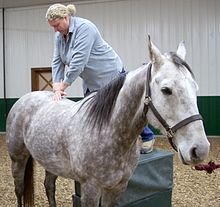Veterinary chiropractic

Veterinary chiropractic, also known as animal chiropractic, is chiropractic for animals – a type of spinal manipulation.[1] Veterinary chiropractors typically treat horses, racing greyhounds, and pets.[2] Veterinary chiropractic is a controversial method due to a lack of evidence as to the efficacy of chiropractic methods.[3] Contrary to traditional medicine, chiropractic therapies are alternative medicine.[4] There is some degree of risk associated with even skilled manipulation in animals as the potential for injury exists with any technique used.[5] The founder of
History
Chiropractic treatment of large animals dates back to the early 1900s.
Efficacy and safety
Aside from the common treatment of racehorses, greyhounds, and pets, some animal chiropractors perform adjustments on exotic animals such as birds, dolphins,
There is some degree of risk associated with even skilled manipulation in animals as the potential for injury exists with any technique used.
Practice
Clinical
The American Veterinary Medical Association (AVMA) guidelines recommend that a veterinarian should examine an animal and establish a preliminary diagnosis before any alternative treatment, like chiropractic, is initiated.[16] Before performing a chiropractic adjustment, the chiropractor examines the animal's gait, posture, vertebrae, and extremities. The chiropractor may also make neurological evaluations.[17] In addition to spinal manipulation, other adjustive procedures can be performed to the extremity joints and cranial sutures.[17] Those that specialize in horses are referred to as "equine chiropractors."[18]
Certification and requirements
There are two certifying agencies in North America, the American Veterinary Chiropractic Association (AVCA) and the International Veterinary Chiropractic Association(IVCA). Earning certification from either agency requires attending an approved animal chiropractic program followed by AVCA or IVCA written and clinical examinations.[19] In some locations, a veterinarian must supervise the treatment or provide a referral for the treatment by a veterinary chiropractor.[20]
The JAVMA describes chiropractic as a complementary and alternative treatment (CAVM).[21] Other CAVM treatments include acupuncture and physical therapy. The AVMA Model Veterinary Practice Act includes CAVM in the definition of veterinary medicine, and that standard has been adopted in 20 states as of 2016[update].[22] Different provisions are listed for each individual state regarding the use of CAVM on animals, most of which require some type of veterinary input such as supervision or referral.[23] Veterinary chiropractic is not recognized by the American Chiropractic Association as being chiropractic.[24]
References
- ^ PMID 21056301.
- ISBN 0-85369-534-2. Retrieved April 22, 2008.
- ^ a b c Daniel Kamen (2001). "Politics and technique". Dyn Chiropr. 19 (13).
- PMID 10572672.
- ^ PMID 10738593.
- ^ ISBN 9781455744466.
- ^ a b "Complementary and alternative veterinary medicine—such as acupuncture, herbs and chiropractic—becoming more mainstream" (Press release). American Veterinary Medical Association. July 14, 2007. Archived from the original on May 20, 2008. Retrieved May 30, 2008.
- ^ "Scope of Practice: Complementary and alternative veterinary medicine (CAVM) and other practice act exemptions". American Veterinary Medical Association. May 2019. Retrieved March 22, 2016.
- ^ "More Pet Owners Turn To Pet Chiropractors". KMGH-TV. May 10, 2011.
- ^ "Animal chiropractors treat elephants, iguanas, turkeys, pigs, llamas, dogs and cats". Daily News. Associated Press. April 21, 2013.
- PMID 27012508.
- PMID 34564593.
- PMID 18089466.
- PMID 17424592.
- ^ a b David W. Ramey (2000). "Veterinary Chiropractic". Chirobase.
- PMID 11394818.
- ^ ISBN 0-8117-2962-1. Retrieved April 23, 2008.
- ISBN 0-7668-4849-3. Retrieved April 23, 2008.
- ^ "Steps to Certification". American Veterinary Chiropractic Association. Retrieved December 29, 2013.
- ^ "State Legislative Resources - Issues". www.avma.org. Archived from the original on April 17, 2008. Retrieved May 19, 2008.
- PMID 12830858.
- ^ "Model Veterinary Practice Act". American Veterinary Medical Association. Retrieved November 19, 2021.
- ^ "Scope of Practice: Complementary and alternative veterinary medicine (CAVM) and other practice act exemptions". American Veterinary Medical Association. Retrieved November 19, 2021.
- ^ ACA House of Delegates (1994). "'Veterinary' chiropractic". American Chiropractic Association. Archived from the original on May 17, 2008.
